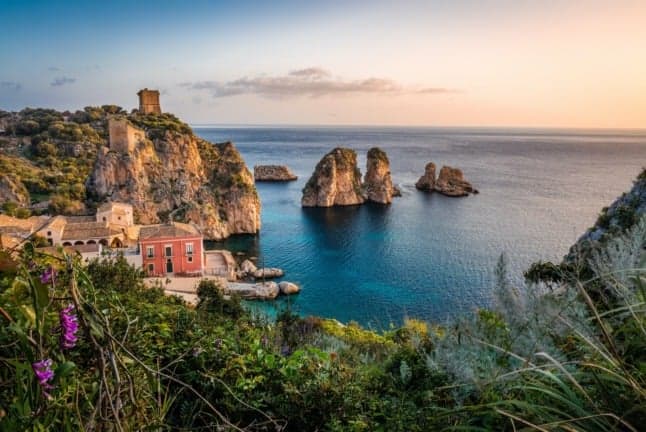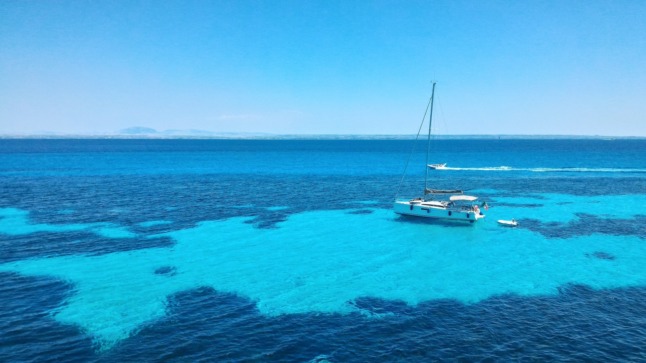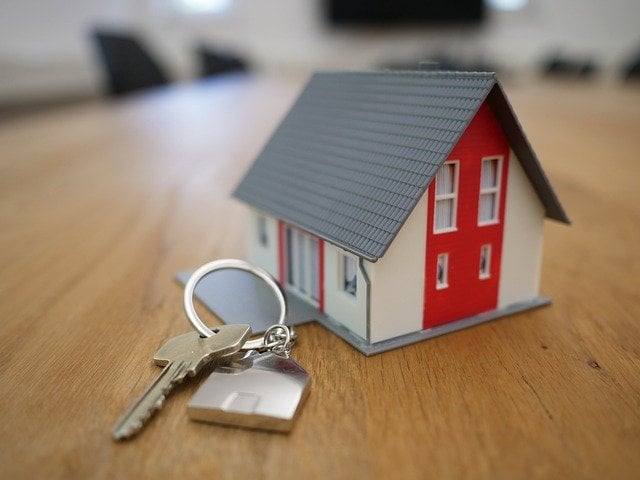Italian property roundup: Best time for Americans to buy and a private island on sale

Fancy owning your very own slice of Sicilian paradise? From a private Italian island on sale to why now might be the best time for Americans to buy property in Italy, catch all the Italian property news you may have missed in The Local's weekly roundup.
Why now might be the best time for Americans to buy property in Italy
American dollars are buying more euros than around a year ago, meaning increased Italian property purchasing power with US dollars.
Throughout 2021, the euro has steadily decreased in value against the US dollar, as can be seen in this graph. The current strength of the dollar means that you'll need less cash to buy a property in euros than you would a year ago.
Based on today's rate, a property in Italy selling for €100,000 would require $113,478 dollars.
READ ALSO:
- The real cost of buying a house in Italy as a foreigner
- Why now is the ‘best’ time to buy property in Italy
A year ago the same cost in euros would have required around $123,000 dollars.
Even on a relatively low house price, that's a saving of around $10,000. The margin of course gets bigger if you're dealing with higher value properties. Going up to a property worth €300,000 would mean an extra $27,000 in your pocket in 2022, compared to last year.
If the dollar holds strong and the European Central Bank don't raise their interest rates, now could be a real opportunity to harness the strong dollar.
A Sicilian island is on sale for €10 million
Imagine the difference in US dollars for a ticket item this big. Isola Lunga (also known as Isola Grande), the largest island in the Stagnone - the largest lagoon area in Sicily - is on the market for €10 million. (That's around $100,000 cheaper this year compared to a year ago in dollars).
The island stretches 10km and the portion of the island for sale is 88 hectares, which is also home to some disused buildings that can be renovated.

Sicily's blue sea. A part of that could be yours surrounding your own island. Photo by Antonio Sessa on Unsplash
The Isola Lunga Nature Reserve is a wellness paradise, full of awe-inspiring landscapes and is home to biodiverse flora and fauna.
A dirt road runs through the island, meandering through coastal forests and on one side there's a white sand beach called 'Tahiti' for the beauty and transparency of its sea.
For those interested in purchasing their very own piece of Italian island paradise, the listing and photos can be seen on real estate agent Sotheby's website.
More help for those under 36 to buy their first home
In the government's approved Budget Law for this year, tax incentives for the 'first home bonus' for young people - in this instance categorised as under 36 - have been extended for the whole of 2022.
The scheme is aimed at young people hoping to get on the property ladder, which offers tax cuts and help with mortgages.
READ ALSO: Under 36? Here’s how Italy plans to help you buy a house
The idea behind the bonus is to eliminate VAT on taxes relating to deeds transfers and the mortgage on the purchase of a home, thereby helping young homebuyers secure a mortgage.
It's worked well so far with a boom in mortgage applications from young people under 36, according to data from MutuiOnline.
First home mortgages are up 44 percent compared to 2020, with the under 36 incentive scheme reported as a driving factor in the increase.
The report found that 80.6 percent of mortgages requested by this age group in 2021 were for the purchase of their first home. In the last quarter of 2021, nine out of ten mortgages requested by young people were for first homes.
The most popular terms were those of over 25 years, increasing from 46.3 percent in 2020 to 56.6 percent in 2021.
The average amount requested by young people reached an all-time high last year, at €141,800 - as well as for mortgages with a Loan-to-Value of over 80 percent. That's 44 percent more than in 2020.
READ ALSO: Do you have to be Italian to claim Italy’s building bonuses?

Italy has seen a boom in mortgage applications from those under 36. Photo: Jens Neumann / Pixabay
According to the figures, a young person under 36 applying for a mortgage is on average 30 years old, wants a mortgage term of around 27 years and earns €1,758.
In case you missed it
After renovation plans hung in the balance for homeowners hoping to take advantage of the government’s hugely popular superbonus 110 at the end of 2021, the Italian government has provided some relief by extending the measure into 2022.
The superbonus on single family homes has been approved for the whole of this year, as published in the Budget Law 2022 on December 30th, 2021.
Italy introduced the ‘superbonus 110‘ in May 2020 to kick-start a sluggish economy following the impacts of the pandemic and to breathe new life into the nation's many neglected properties. It offers homeowners a tax deduction of up to 110 percent on expenses related to making energy upgrades and reducing seismic risk.
READ ALSO:
- What will Italy’s new budget mean for you in 2022?
- How to stay out of trouble when renovating your Italian property
- Italy’s building bonus: Can you really claim back the cost of renovating property?
Even though the deadlines are different depending on the property type, single unit homes can benefit from the superbonus throughout the whole of 2022.
30 percent of works must be completed by June 30th 2022 to be able to claim for the whole year, however.
If less than this amount of construction work is carried out by then, no more superbonus will be made available for that property from June until December 2022.
The news gives more time to those who’ve been stuck in queues due to builder shortages and bureaucratic delays and who potentially faced the possibility of this bonus not being continued for this category past 2021.
Other types of buildings have even more opportunity to claim the bonus. Condominiums, owners of buildings consisting of two to four units and third sector organisations will be able to take advantage of the benefit until 2025, with a sliding scale: 110 percent remains valid until 31 December 2023, dropping to 70 percent in 2024 and 65 percent in 2025.
For more information on how the superbonus applies from 2022 onwards and the new deadlines, check HERE.
And there's a raft of other building bonuses included in the Budget Law 2022. See HERE for how else you can get help with the costs of renovating and upgrading your property.
If you have any tips, stories or thoughts on what we should include in the next edition of the property roundup, we’d love to hear from you. Email us here.
See more in The Local’s Italian property section.
Comments
See Also
Why now might be the best time for Americans to buy property in Italy
American dollars are buying more euros than around a year ago, meaning increased Italian property purchasing power with US dollars.
Throughout 2021, the euro has steadily decreased in value against the US dollar, as can be seen in this graph. The current strength of the dollar means that you'll need less cash to buy a property in euros than you would a year ago.
Based on today's rate, a property in Italy selling for €100,000 would require $113,478 dollars.
READ ALSO:
- The real cost of buying a house in Italy as a foreigner
- Why now is the ‘best’ time to buy property in Italy
A year ago the same cost in euros would have required around $123,000 dollars.
Even on a relatively low house price, that's a saving of around $10,000. The margin of course gets bigger if you're dealing with higher value properties. Going up to a property worth €300,000 would mean an extra $27,000 in your pocket in 2022, compared to last year.
If the dollar holds strong and the European Central Bank don't raise their interest rates, now could be a real opportunity to harness the strong dollar.
A Sicilian island is on sale for €10 million
Imagine the difference in US dollars for a ticket item this big. Isola Lunga (also known as Isola Grande), the largest island in the Stagnone - the largest lagoon area in Sicily - is on the market for €10 million. (That's around $100,000 cheaper this year compared to a year ago in dollars).
The island stretches 10km and the portion of the island for sale is 88 hectares, which is also home to some disused buildings that can be renovated.

The Isola Lunga Nature Reserve is a wellness paradise, full of awe-inspiring landscapes and is home to biodiverse flora and fauna.
A dirt road runs through the island, meandering through coastal forests and on one side there's a white sand beach called 'Tahiti' for the beauty and transparency of its sea.
For those interested in purchasing their very own piece of Italian island paradise, the listing and photos can be seen on real estate agent Sotheby's website.
More help for those under 36 to buy their first home
In the government's approved Budget Law for this year, tax incentives for the 'first home bonus' for young people - in this instance categorised as under 36 - have been extended for the whole of 2022.
The scheme is aimed at young people hoping to get on the property ladder, which offers tax cuts and help with mortgages.
READ ALSO: Under 36? Here’s how Italy plans to help you buy a house
The idea behind the bonus is to eliminate VAT on taxes relating to deeds transfers and the mortgage on the purchase of a home, thereby helping young homebuyers secure a mortgage.
It's worked well so far with a boom in mortgage applications from young people under 36, according to data from MutuiOnline.
First home mortgages are up 44 percent compared to 2020, with the under 36 incentive scheme reported as a driving factor in the increase.
The report found that 80.6 percent of mortgages requested by this age group in 2021 were for the purchase of their first home. In the last quarter of 2021, nine out of ten mortgages requested by young people were for first homes.
The most popular terms were those of over 25 years, increasing from 46.3 percent in 2020 to 56.6 percent in 2021.
The average amount requested by young people reached an all-time high last year, at €141,800 - as well as for mortgages with a Loan-to-Value of over 80 percent. That's 44 percent more than in 2020.
READ ALSO: Do you have to be Italian to claim Italy’s building bonuses?

According to the figures, a young person under 36 applying for a mortgage is on average 30 years old, wants a mortgage term of around 27 years and earns €1,758.
In case you missed it
After renovation plans hung in the balance for homeowners hoping to take advantage of the government’s hugely popular superbonus 110 at the end of 2021, the Italian government has provided some relief by extending the measure into 2022.
The superbonus on single family homes has been approved for the whole of this year, as published in the Budget Law 2022 on December 30th, 2021.
Italy introduced the ‘superbonus 110‘ in May 2020 to kick-start a sluggish economy following the impacts of the pandemic and to breathe new life into the nation's many neglected properties. It offers homeowners a tax deduction of up to 110 percent on expenses related to making energy upgrades and reducing seismic risk.
READ ALSO:
- What will Italy’s new budget mean for you in 2022?
- How to stay out of trouble when renovating your Italian property
- Italy’s building bonus: Can you really claim back the cost of renovating property?
Even though the deadlines are different depending on the property type, single unit homes can benefit from the superbonus throughout the whole of 2022.
30 percent of works must be completed by June 30th 2022 to be able to claim for the whole year, however.
If less than this amount of construction work is carried out by then, no more superbonus will be made available for that property from June until December 2022.
The news gives more time to those who’ve been stuck in queues due to builder shortages and bureaucratic delays and who potentially faced the possibility of this bonus not being continued for this category past 2021.
Other types of buildings have even more opportunity to claim the bonus. Condominiums, owners of buildings consisting of two to four units and third sector organisations will be able to take advantage of the benefit until 2025, with a sliding scale: 110 percent remains valid until 31 December 2023, dropping to 70 percent in 2024 and 65 percent in 2025.
For more information on how the superbonus applies from 2022 onwards and the new deadlines, check HERE.
And there's a raft of other building bonuses included in the Budget Law 2022. See HERE for how else you can get help with the costs of renovating and upgrading your property.
If you have any tips, stories or thoughts on what we should include in the next edition of the property roundup, we’d love to hear from you. Email us here.
See more in The Local’s Italian property section.
Join the conversation in our comments section below. Share your own views and experience and if you have a question or suggestion for our journalists then email us at [email protected].
Please keep comments civil, constructive and on topic – and make sure to read our terms of use before getting involved.
Please log in here to leave a comment.